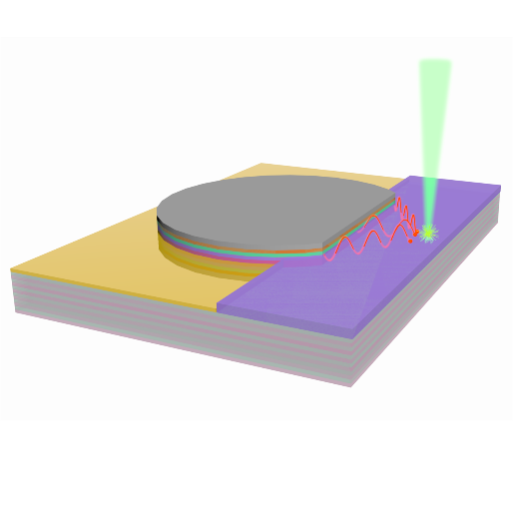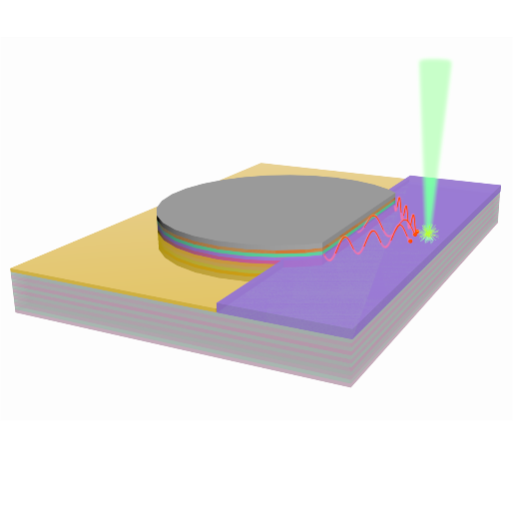Plant-Based Strategy for Harvesting Light
When it comes to extracting energy from sunlight, plants and solar cells are wired differently. One of the main distinctions is that a plant has separate structures for absorbing sunlight and for converting that energy into a usable electric charge, whereas a solar cell has one structure that does both. However, calculations suggest that light-harvesting devices, such as solar cells and photodetectors, could be made more efficient by adopting the plant strategy. A new experiment by Stephen Forrest from the University of Michigan and his colleagues has replicated plant-like separation in an organic photodetector [1]. The reported efficiency is better than that of simpler photodetectors, but further work will be needed to make this plant mimicry competitive with current solar-cell technology.
The two main photosynthetic structures in plants are the antenna complexes (ACs) and the reaction centers (RCs). When a photon from the Sun strikes an AC, its energy is absorbed, creating in the AC an excited molecular state called an exciton. This exciton moves through the plant to an RC, where the exciton is converted into a free electron that the plant uses to generate chemical energy. One advantage of this division of labor is that plants can grow relatively small RCs, reducing a background noise called dark current. A low dark current is a key ingredient to efficient light harvesting.
Like a plant, a solar cell absorbs sunlight and creates excitons, but it doesn’t then send the excitons somewhere else to convert them to free electrons. “It all happens in the same place,” Forrest says. That means that the conversion area can’t be made smaller than the absorption area to improve efficiency. Researchers have considered alternative solar-cell designs that mimic the way plants work, but the challenge has been moving the excitons from absorption sites to conversion sites. “The problem with excitons is they can only travel a few nanometers,” Forrest explains. Plants get past this roadblock by having a large network of RCs as well as a protein scaffolding that helps in the energy transfer. But these solutions are unavailable to solar-cell designers.
The idea that Forrest and his team came up with is to trade excitons for polaritons. A polariton is a hybrid particle in which an exciton couples to a photon. This light-matter mixture allows a polariton to travel fast and far like a photon while also letting it interface with an electronic device with the same ease as an exciton.
After years of trial and error, Forrest and colleagues have now made the first polariton-based photodetector. The device consists of an organic film laid on top of a mirror-like surface. To create polaritons, the researchers shine light at a focused spot on the film. “If you do the setup just right, a polariton formed by optical excitation will go zipping along the surface at really high velocity,” Forrest says. “It doesn’t live long, but it doesn’t have to live very long to go a long distance.” To observe polariton propagation, the team placed a detector—one that converts excitons into charge—on one side of the organic film. They found that polaritons could travel as much as 0.3 mm from the focused beam spot to the detector—more than 1000 times farther than excitons can travel. The team measured the efficiency of the photodetector in terms of the current produced per unit of optical power received. They found that the plant-inspired device performed better than simple silicon photodiodes but worse than state-of-the-art photodetectors.
The team is now looking to improve the performance of their polariton-generating scheme. One way would be to optimize the device’s geometry by surrounding a large-area organic film with a ring-shaped detector. Such a design would mimic a plant, with the AC and RC roles played, respectively, by the film and the detector. Forrest speculates that such a device could have a higher power conversion efficiency than current solar cells with their non-plant-like design.
Polariton researcher Stéphane Kéna-Cohen from Montreal Polytechnic says the new design “allows the researchers to harvest light from a larger effective area than would otherwise be possible.” He compares the polariton photodetector to a luminescent solar concentrator—a light-harvesting device that uses a plastic material to collect sunlight and funnel it to a small solar cell. Both technologies are easily integrated into electronics, but concentrators can have a larger collection area—thanks to the 10-cm propagation length of photons inside the plastic material. For polariton-based devices to be competitive, Kéna-Cohen says, researchers will need to improve the propagation length of polaritons beyond the 100 that Forrest’s team observed.
–Michael Schirber
Michael Schirber is a Corresponding Editor for Physics Magazine based in Lyon, France.
References
- B. Liu et al., “Photocurrent generation following long-range propagation of organic exciton-polaritons,” Optica 9, 1029 (2022).







